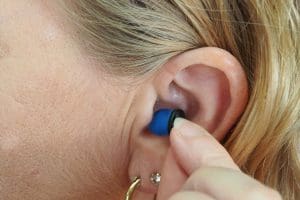You know what they say: “a stitch in time saves nine.” Taking a few moments each day to properly care for your hearing aids will prevent a lot of cost and inconvenience in the future. If you want to make sure your hearing aids stay in good shape and last as long as possible, it’s important to take care of them. And as anyone who has ever had to deal with hearing loss knows, regular cleaning is a big part of this process.
You may not think about it, but your hearing aid is actually a delicate piece of technology. While it protects your hearing, it’s susceptible to damage by moisture, dirt and debris, and corrosion. After all, your ear is a moist, dark place in your body- it’s not the ideal environment to keep a precision electronic device.
If you don’t take the proper steps to care for your hearing aids, you could end up reducing functionality and reducing its lifespan. In order to keep your hearing aid in good condition, proper maintenance is necessary. Here are some tips for keeping your hearing aid clean and working properly at home.
Tips to Properly Maintain Your Hearing Aids at Home
1. Avoid Moisture
Wear your hearing aid in a dry environment, and avoid going swimming or exposing your hearing aid to water. Moisture can cause corrosion and damage to the internal components of the device making them less effective. This means that you should not leave your hearing aid in a place where it could be submerged in water or exposed to steam or other sources of heat or moisture. While it’s important for users to avoid moisture in general, you need dry place where you can store your hearing aids when not in use so that they’re protected from moisture and other damaging elements throughout the day (e.g., humidity).
2. Change Hearing Aid Batteries Often
Change your hearing aid batteries as soon as you notice them running low (most hearing aids will beep to alert you). Batteries are an important part of how our devices work and they need to be changed regularly to keep them working properly—even more so than other electronic devices like cell phones or laptops! The best thing about changing batteries is that there’s really no wrong way to do it; as long as they’ve been used according to manufacturer instructions and haven’t been exposed to moisture. This will ensure that you are always hearing at optimal levels, and you won’t have to deal with a sudden drop in volume or other issues caused by weak batteries. Alternatively, rechargeable hearing aids like the ReSound One or Phonak Paradise are an option for most people now. Most of these devices also have reduced moisture issues because of there not being a battery door on the device- it’s one less place where moisture can get in.
3. Keep Devices Free of Earwax
Ear wax is natural and normal, but it can build up inside your ear canal and clog up your hearing aid’s components if left unchecked! Use a warm washcloth once per day to wipe away any excess wax buildup on the outside of your device, so it doesn’t get stuck inside there when cleaning it off with alcohol wipes later on.
4. Always Handle With Care

Hearing aids are delicate instruments that need to be handled carefully in order for them to work correctly—and that means avoiding dropping them on hard surfaces like concrete floors or pavement! Hearing aids are delicate electronic devices. When handling or cleaning your hearing aids, always be careful not to drop them or subject them to impact, as this could result in damage or malfunctioning of the aid.
5. Use a Hearing Aid Dryer
Use a stay-dry box to store your hearing aids when they’re not in use, which will keep them dry and free from moisture or dampness that can cause damage over time. It is important that you keep your hearing aids in a dry place because exposure to moisture can damage the delicate electronic components in your hearing aids. The moisture may also cause mold or mildew to form inside the unit, which can cause ear infections and other health issues for those who have prolonged exposure. At Wichita Falls Hearing, we keep a variety of hearing aid dryers and sanitizers in stock. Let us know if we can help you pick the right one for you.
6. Schedule Routine Cleanings
If you don’t wear your hearing aids enough, they’ll become clogged with wax and turn into mini sound prisons rather than amplifiers. The next step to cleaning your hearing aids is to schedule routine appointments for cleanings, as they will increase the lifespan of your instruments. If you have any questions regarding how to clean your hearing aids between visits, make sure and ask us while you’re in the office. We’re happy to teach you!
Why Is It Important to Have Properly Cleaned Hearing Aids?
However, many people fail to do so, and sometimes even try to avoid it altogether. This is problematic in both the short and long term. In the short-term, earwax build-up can interfere with your hearing aid’s function, so cleaning is necessary to keep them working properly. In the long term, if you don’t maintain the cleanliness of your hearing aids the device will degrade faster than normal and will not last as long as it should. If you wish to avoid both these problems, it is far better to spare ten minutes each week to clean them properly. Just a few minutes every week will spare you a lot of inconvenience down the road!
Cleaning Your Hearing Aid at Home
If you wear hearing aids and you want to maintain their health and longevity, you need to know what you should not do with them!
- Don’t use anything wet to clean your hearing aids. Even rubbing alcohol can damage some microphones and receivers to the point they require laboratory repair.
- Cealn your hearing aids daily.
- Ear wax is like any other wax- it gets more fluid as it gets warmer. Because of this, it’s best to clean your hearing aids in the morning before you put them in- doing it in the evening after taking them off tends to “spread the wax around”.
- Use a firm bristed, dry toothbrush to clean all exterior portions of the hearing aid.
- You can clean the “wax guard” on your hearing aid (if equipped) with this toothbrush as well.
- If your hearing aid does not have a wax guard, ask your hearing care provider how to properly use a wax loop to clean your hearing aids.
Final Notes
If you want to keep your hearing aid functioning properly, you need to take the aforementioned steps to ensure that it’s kept in good condition. Maintaining your hearing aids is much easier than you think. With proper care, you can keep your hearing aids working at optimal levels for years. The bad news: That maintenance takes daily effort on your part. But it’s worth it. So include cleaning the hearing aid as the main part of your schedule to increase their longevity and efficacy!
For all of your hearing aid-related questions, and for more information about proper maintenance and care, get in touch with our team here at Wichita Falls Hearing! Our goal is to increase your quality of life by setting you up with the right products to amplify and protect your hearing. Don’t hesitate to call us today at 833-999-1940!

